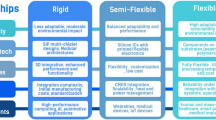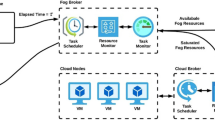Abstract
There has been an outstanding use of memory storage of processors as current applications: Artificial Intelligence-based applications, 3D-reconstruction or Blockchain ones, take advantage of their large computing effort, as well as their ability to support greedy treatments, and it grows the concern about providing reasonable resources for an efficient performance. This increase in demand requires optimized hardware configurations. In this context, the multi agent approach is a suitable solution to control the required resources for a multi-technology application. This paper investigates the scenario in which an embedded architecture implemented on FPGA is using a dynamic reconfigurable system that involves a multi-agent-based control part allowing optimizing and scheduling resources for technology processing requests. Hence, according to the required technology, the minimum of resources is selected. In a first time, performance is evaluated in terms of number of slices’ resources and task execution time for both a fixed and a dynamic reconfigurable architecture. A Dynamic Partial Reconfiguration is used to minimize efficiently the number of agents and consequently to minimize the allocated resources. The proposed dynamic reconfigurable architecture allows to save efficiently resources and execution time constraints.










Similar content being viewed by others
Data availability
There is no data availability.
References
Allal A, Sahnoun M, Adjoudj R, Benslimane SM, Mazar M (2021) Multi-agent based simulation-optimization of maintenance routing in offshore wind farms. Comput Ind Eng 157:107342
Allouche M, Frikha T, Mitrea M, Memmi G, Chaabane F (2021) Lightweight Blockchain Processing. Case Study: Scanned Document Tracking on Tezos Blockchain. Appl Sci 11(15):7169. https://doi.org/10.3390/app11157169
Balouch S et al (2022) Optimal scheduling of demand side load Management of Smart Grid Considering Energy Efficiency. Energy Res 18:2022. https://doi.org/10.3389/fenrg.2022.861571
Barreteau O (1998) A multi agent system for exploiting the sustainability of irrigated systems: Dynamique des interactions et modes d’Organisation. Ecole Nationale du Génie Rural des Eaux et des Forêts, Montpellier
Chakraborty C, Kishor A, Rodrigues JJPC (2022) Novel enhanced-Grey wolf optimization hybrid machine learning technique for biomedical data computation. Comput Electr Eng 99:107778
Cutierrez Garcia JO, Mong Sim K (2015) Agent-based cloud bag-of-tasks execution. J Syst Softw 104:17–31
Dhouioui M, Frikha T (2021) Design and implementation of a radar and camera-based obstacle classification system using machine-learning techniques. J Real-Time Image Proc 18:2403–2415. https://doi.org/10.1007/s11554-021-01117-8
Domínguez R, Cannella S, Framinan JM (2015) SCOPE: A Multi-Agent system tool for supply chain network analysis, IEEE EUROCON 2015 - International Conference on Computer as a Tool (EUROCON), pp. 1–5, https://doi.org/10.1109/EUROCON.2015.7313688
Duan Y, Cui BX, Xu XH (2012) A multi-agent reinforcement learning approach to robot soccer. Artif Intell Rev 38:193–211. https://doi.org/10.1007/s10462-011-9244-8
Dudek G, Jenkin MRM, Milios E, Wilkes D (1996) A taxonomy for multi-agent robotics. Auton Robot 3:375–397. https://doi.org/10.1007/BF00240651
Eldesokey HM, Abd El-atty SM, El-Shafai W, Amoon M, Abd El-Samie FE (2021) Hybrid swarm optimization algorithm based on task scheduling in a cloud environment. Int J Commun Syst 34:e4694
Ferber J (1995) Les Systèmes multi-agents. InterEditions, p 544
Fiosina J, Fiosins M (2013) Density-Based Clustering in Cloud-Oriented Collaborative Multi-Agent Systems. In: Pan JS, Polycarpou MM, Woźniak M, de Carvalho ACPLF, Quintián H, Corchado E (eds) Hybrid Artificial Intelligent Systems. HAIS 2013. Lecture notes in computer science, vol 8073. Springer, Berlin. https://doi.org/10.1007/978-3-642-40846-5_64
Frikha T, Amor NB, Lahbib K, Diguet JP, Abid M (2013) A data adaptation approach for a HW/SW mixed architecture (case study: 3D application). WSEAS Trans Circuits Syst 12(9):263–272
Frikha T, Siala Y, Louati M, Abid M (2016) Use of ridgelets, curvelets application for face recognition: Case study: MASrt identity card, 2016 2nd International Conference on Advanced Technologies for Signal and Image Processing (ATSIP), pp. 393–397, https://doi.org/10.1109/ATSIP.2016.7523130
Frikha T, Ben Amor N, Diguet JP, Abid M (2019) A novel Xilinx-based architecture for 3D-graphics. Multimed Tools Appl 78:14947–14970. https://doi.org/10.1007/s11042-018-6886-4
Frikha T, Chaabane F, Aouinti N, Cheikhrouhou O, Ben Amor N, Kerrouche A (2021) Implementation of Blockchain con-sensus algorithm on embedded architecture. Secur Commun Netw 2021:9918697
Frikha T, Chaari A, Chaabane F, Cheikhrouhou O, Zaguia A (2021) Healthcare and fitness data management using the IoT-based Blockchain platform. J Healthc Eng 2021:9978863
Garcia CC, Cardenas PF, Pazmino RS, Puglisi L, Santonja RA (2013) A cooperative multi-agent robotics system: design and modelling. Expert Syst Appl 40(12):4737–4748, ISSN 0957-4174. https://doi.org/10.1016/j.eswa.2013.01.048
Gatti M et al (2014) Large-Scale Multi-agent-Based Modeling and Simulation of Microblogging-Based Online Social Network. In: Alam S, Parunak H (eds) Multi-Agent-Based Simulation XIV. MABS 2013. Lecture notes in computer science, vol 8235. Springer, Berlin. https://doi.org/10.1007/978-3-642-54783-6_2
Ghorbel A, Ben Amor N, Jallouli M (2015) Towards a parallelization and performance optimization of Viola and Jones algorithm in heterogeneous CPU-GPU mobile system. International conference on intelligent systems design and applications, IEEE ISDA 2015, pp. 529–533
Gorodetski V, Kotenko IA (2002) The multi-agent systems for computer network security assurance: Frameworks and case studies, ieee international conference artificial intelligence systems, pp. 297–302
Govinda K, Sathiyamoorthy E (2012) Agent based security for cloud computing using obfuscation. Process Eng 38:125–129
Goyal S, Bhushan S, Kumar Y, Rana AHS, Bhutta MR, Ijaz MF, Son Y (2021) An optimized framework for energy-resource allocation in a cloud environment based on the whale optimization algorithm. Sensors. 21(5):1583
Guesmi A, Alouani I, Baklouti M, Frikha T, Abid M (2022) SIT: Stochastic Input Transformation to Defend Against Adversarial Attacks on Deep Neural Networks. IEEE Des Test. https://doi.org/10.1109/MDAT.2021.3077542
Guo C, Ci S, Zhou Y, Yang Y (2021) A survey of energy consumption measurement in embedded systems. IEEE Access 9:60516–60530. https://doi.org/10.1109/ACCESS.2021.3074070
Helbing D (2012) Agent-based modeling, Social self-Organization, pp. 25–70
Hu F, Mao X (2016) Cross-clouds services autonomic management approach based on self-organizing multi- agents technology. Concurr Comput Pract Exp 28(111):3213–3237
Iñigo-Blasco P, Diaz-del-Rio F, Romero-Ternero MC, Cagigas-Muñiz D, Vicente-Diaz S (2012) Robotics software frameworks for multi-agent robotic systems development. Robot Auton Syst 60(6):803–821,ISSN 0921-8890. https://doi.org/10.1016/j.robot.2012.02.004
Issaoui S, Ejbeli R, Frikha T, Abid M (2016) Embedded approach for edge recognition: Case study: Vehicle registration plate recognition, 2016 13th International Multi-Conference on Systems, Signals & Devices (SSD), pp. 336–341, https://doi.org/10.1109/SSD.2016.7473747
Jayanetti A, Halgamuge S, Buyya R (2022) Deep reinforcement learning for energy and time optimized scheduling of precedence-constrained tasks in edge–cloud computing environments. Futur Gener Comput Syst 137:14–30
Jiang Y, Jiang JC (2014) Understanding social networks from a multiagent perspective. IEEE Trans Parallel Distrib Syst 25(110):2743–2759
Kaur J, Ahmed S, Kumar Y, Alaboudi A, Jhanjhi NZ et al (2021) Packet optimization of software defined network using lion optimization. Comput Mater Contin 69(2):2617–2633
Khaleel MI (2022) Multi-objective optimization for scientific workflow scheduling based on performance-to-power ratio in fog–cloud environments. Simul Model Pract Theory 119:102589
Khayat M, Awasthi A (2016) An intelligent multi-agents based model for collaborative logistics systems. Transp Res Proc 12:325–338
Kishor A, Chakarbarty C (2021) Task offloading in fog computing for using smart ant Colony optimization. Wirel Pers Commun 127:1683–1704
Kishor A., Chakraborty C., Jeberson W., “Reinforcement learning for medical information processing over heterogeneous networks”, Multimed Tools Appl, 2021, vol 16, p. 23983–24004, 2021.
Ktari J, Frikha T, Hamdi M, Elmannai H, Hmam H (2022) Lightweight AI Framework for Industry 4.0 Case Study: Water Meter Recognition. Big Data Cogn Comput 6:72
Ktari J, Frikha T, Ben Amor N, Louraidh L, Elmannai H, Hamdi M (2022) IoMT-based platform for E-health monitoring based on the Blockchain. Electronics 11(15):2314. https://doi.org/10.3390/electronics11152314
Manikandan N, Divya P, Janani S (2022) BWFSO: hybrid black-widow and fish swarm optimization algorithm for resource allocation and task scheduling in cloud computing. Mater Today: Proc 62(Part 7):4903–4908
Manikandan N, Gobalakrishnan N, Pradeep K (2022) Bee optimization based random double adaptive whale optimization model for task scheduling in cloud computing environment. Comput Commun 187:35–44
Mechtri L, Tolba FD, Ghanemi S (2012) MASID: Multi-Agent System for Intrusion Detection in MANET, 2012 Ninth International Conference on Information Technology - New Generations, pp. 65–70, https://doi.org/10.1109/ITNG.2012.18
Milička P, Šůcha P, Vanhoucke M, Maenhout B (2022) The bilevel optimisation of a multi-agent project scheduling and staffing problem. Eur J Oper Res 296(1):72–86
Nguyen CP, Flueck AJ (2012) Agent based restoration with distributed energy storage support in MASrt grids. IEEE Trans Smart Grid 3(2):1029–1038. https://doi.org/10.1109/TSG.2012.2186833
Nikbazm R, Ahmadi M (2014) Agent-based resource discovery in cloud computing using bloom filters, 4th International Conference on Computer and Knowledge Engineering, pp. 325–357
Ota J (2006) Multi-agent robot systems as distributed autonomous systems. Adv Eng Inform 120(11):59–70
Rani S, Koundal D, Kavita, Ijaz MF, Elhoseny M, Alghamdi MI (2021) An Optimized Framework for WSN Routing in the Context of Industry 4.0. Sensors 21(19):6474
Rauh J, Rid W, Hager K (2016) Agent-based modeling of traffic behavior in growing metropolitan areas. Transp Res Proc 10:306–315
Sarika S, Paul V (2015) AgentTab: an agent based approach to detect tabnabbing attack. Procedia Comput Sci 46:574–581
Seçkiner SU, Koç A (2022) Agent-based simulation and simulation optimization approaches to energy planning under different scenarios: a hospital application case. Comput Ind Eng 169:108163
Sim KM (2012) Agent-based cloud computing. IEEE Trans Serv Comput 5(14):564–577
Soriano A, Bernabeu EJ, Valera A, Vallés M (2013) Collision avoidance of Mobile robots using multi-agent systems. In: Omatu S, Neves J, Rodriguez J, Paz Santana J, Gonzalez S (eds) Distributed computing and artificial intelligence. Advances in intelligent systems and computing, vol 217. Springer, Cham. https://doi.org/10.1007/978-3-319-00551-5_52
Tang X, Shi C, Deng T, Wu Z, Yang L (2021) Parallel random matrix particle swarm optimization scheduling algorithms with budget constraints on cloud computing systems. Appl Soft Comput 113(Part A):107914
van der Togt A, Werkman E, van Pruissen O (2014) Energy Efficiency Comparison of a Centralized and a Multi-agent Market Based Heating System in a Field Test. Energy Procedia 62:170–179
Vytelingum P, Voice TD, Ramchurn SD, Rogers A, Jennings NR (2010) Agent-based micro-storage management for the MASrt grid, 9th International Conference on Autonomous Agents and Multiagent Systems, vol. 1, no. 11, pp. 39–46
Wangapisit O, Taniguchi E, Teo JSE, Gul Qureshi A (2014) Multi-agent Systems Modelling for Evaluating Joint Delivery Systems. Procedia Soc Behav Sci 125:472–483, ISSN 1877-0428. https://doi.org/10.1016/j.sbspro.2014.01.1489
Yu T, Huang J, Chang Q (2021) Optimizing task scheduling in human-robot collaboration with deep multi-agent reinforcement learning. J Manuf Syst 60:487–499
Zaabar B, Cheikhrouhou O, Jamil F, Ammi M, Abid M (2021) HealthBlock: a secure blockchain-based healthcare data management system. Comput Netw 200:108500, ISSN 1389-1286. https://doi.org/10.1016/j.comnet.2021.108500
Author information
Authors and Affiliations
Corresponding author
Additional information
Publisher’s note
Springer Nature remains neutral with regard to jurisdictional claims in published maps and institutional affiliations.
Rights and permissions
Springer Nature or its licensor (e.g. a society or other partner) holds exclusive rights to this article under a publishing agreement with the author(s) or other rightsholder(s); author self-archiving of the accepted manuscript version of this article is solely governed by the terms of such publishing agreement and applicable law.
About this article
Cite this article
Frikha, T., Chaabane, F., Halima, R.B. et al. Embedded decision support platform based on multi-agent systems. Multimed Tools Appl 82, 32607–32633 (2023). https://doi.org/10.1007/s11042-023-14843-x
Received:
Revised:
Accepted:
Published:
Issue Date:
DOI: https://doi.org/10.1007/s11042-023-14843-x




